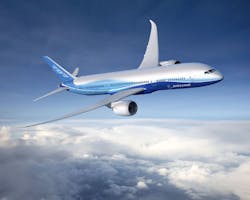Lt. Gov. Owen: Legislative panel to explore ways state can support growing composites industry
TACOMA, Wa., 17 Sept. 2012. From aircraft to fast boats, electric cars, and guitars, the emerging composites industry in the state of Washington is creating an opportunity for new jobs, according to a a release from the Office of Washington Lieutenant Governor Brad Owens.
“Think of composites as the new aluminum,” says James Palmer, an economic development manager for the state Department of Commerce. Palmer defines composites as materials derived from multiple components and advanced processes. They can include Fiberglas, carbon fibers, new metals, or wood. The Boeing Company’s 787 Dreamliner is the first composite airliner in production, with the aircraft’s vertical tailfin and other parts manufactured at the Boeing and Toray plants in Frederickson.
Palmer is among those spearheading efforts to help organize the industry in Washington into its own economic sector. Palmer will be the lead-off presenter at the meeting of the Legislative Committee on Economic Development and International Relations (LCEDIR) at the LeMay America’s Car Museum beginning at 9 a.m. Sept. 21 in Tacoma. The 13-member, bipartisan committee, chaired by Lt. Gov. Brad Owen, meets two or three times a year to examine issues and industries that impact the state’s economy.
The Port of Port Angeles, along with area research and manufacturing representatives, recently proposed a composites manufacturing demonstration facility on about 20 acres on West Sequim Bay and is seeking a federal grant to fund it. The facility would be in addition to the port's existing Composites Manufacturing Campus near the regional airport. Angeles Composite Technologies Inc., which manufactures and distributes aircraft parts around the world, expanded to the airport site earlier this year.
Professors within the College of Engineering and Architecture at Washington State University in Pullman will highlight research that will be applicable to a range of possible new and innovative products. The WSU Composite Materials and Engineering Center has embarked on a variety of projects aimed at making lighter, stronger construction materials from plastics and wood, improving pavement and concrete, and building stronger bridge decks in cold regions, long-life batteries, and products made from recyclable materials.
Similarly, the Automobili Lamborghini Advanced Composite Structures Laboratory at the University of Washington was established three years ago to analyze the impacts of lightning, bird strikes and severe crashes on composite materials used in automobile and aircraft manufacturing, as well as conceptual design. Aeronautical engineers at the UW have partnered with Boeing for several years on aerospace applications around composites.
Palmer points out while there are a number of companies and institutions working in composites, the Washington-based companies have yet to organizeinto a regionally focused, industry-led trade association. He is encouraging Washington’s companies to self-identify into a regional association in order for the Commerce department help the industry improve job and market opportunities for Washington companies and the state’s workforce.
“It is a very rapidly growing industry, in a highly innovative sector that has a lot of potential,” Palmer says. Industry organization will help better communicate the workforce training needs for technical and community colleges training students for high-skilled jobs, identify funding needs for university programs engaged in research and development, as well as focus on new market development and ways to help support the international supply chain around composites.
A separate afternoon meeting following the LCEDIR session will be a Commerce-led roundtable discussion among businesses with the idea of establishing a database of Washington companies working in composites.
The state is not without competition in the industry, Palmer said. South Carolina, for instance, has been “very aggressive” in its recruiting of companies in the composite business. Japan, Spain, and Germany are producing machines that are used in the composite manufacturing process. Michigan has an interest in composites due to the auto industry there and Texas is becoming the base of many composites companies too.
“What we want to know is how the state of Washington can support this important industry so we can create jobs that will lead us into the next century. We will look at whether there are any policies or laws at the state level that are either helping or hurting,” Lt. Gov. Owen says. “The members of our committee are all very interested in supporting any effort that means jobs and opportunities for citizens of Washington.”
The session will be taped then air repeatedly on the state's public affairs network, TVW, starting at 8 p.m. Sept. 24 and can be viewed on the TVW web site as well. A full list of presenters can be found on the meeting agenda. The LeMay America's Car Museum is at 2702 East D. Street in Tacoma, and the session will be in the facilities' Banquet Room.
